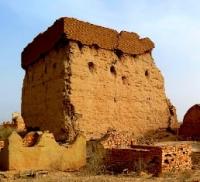You are here
Mausoleum of Khalifa Erezhep.

Tour - travel to Karakalpakstan.
“In a moment, an instant - and life flashes by...
Let this moment shine with fun!
Beware, for life is the essence of creation
How you carry it out, so it will pass"
Omar Khayam.
Photo excursion to monuments of Karkalapakia.
The ruins of the Khalifa-Erezhep mausoleum are located on a natural hill 104.6 meters above sea level on the Mizdakhan necropolis, 146 meters southwest of the Mazlumkhan Sulu mausoleum, 4.7 kilometers west and slightly south of the city of Khojeyli, 1 , 1 km to the north-east of the ancient settlement Gyaur kala (Khojeli) in the Khojeli region of the Republic of Karakalpakstan.
The ruins of the Khalifa-Erezhep mausoleum, dated by the archaeologist A.Yu. Yakubovskiy XII - XIV centuries, once they were a square building measuring 11 × 11 meters. To date, only three of its walls have survived, as well as minor remains of the dome and masonry of burnt polished bricks on the front side.
On the walls there are transitional structures in the form of perspective arched trumpets with strongly elongated heels. According to scholars, the monument was of Sufi origin: this is evidenced by its layout, as well as the name.
According to legend, a saint who preached Islam at the dawn of its spread in these places was buried here. However, many believe that this is the tomb of Adam. However, scientists believe that this burial is identified with the tomb of Gayomard - the first person on Earth from Zoroastrian mythology.
But this is not the only reason why the Erezhepa mausoleum became a place of pilgrimage for people from all over the world. Archaeological studies have shown that the building, erected in the 9th-10th centuries, has a solid foundation, which is based on a reed layer that protects the structure from groundwater and makes it resistant to earthquakes.
From the facade, where the portal was located, only part of the masonry remained, and at the entrance there is a pile of burnt polished bricks. There is an ancient legend dating back to pre-Islamic times that there is a "world clock" that measures the time of human existence.
Every year one brick falls from the walls of this structure, and when the last one falls, the end of the world will come, and life on Earth will dry up. Pilgrims, asking fate to fulfill their cherished desires, built thousands of small pyramids around the tomb from fallen bricks stacked on top of each other.
The number of bricks in the pyramid must certainly be seven, it is not accepted to take bricks from someone else's pyramid - after all, destroying other people's hopes, you cannot build your own happiness. It is considered a sin to take with you at least one brick from Mizdakhan.
No one saw when and how the bricks fell from the wall of the mausoleum, and no one counted the remaining ones in the masonry. At the foot of the monument to Khalifa Erezhep, according to legend, seven companions of the prophet are buried. In addition, "Erezhep" ("Rajab") simultaneously with the person's name denotes the name of the seventh month in the Arabic calendar.
Sagana, also known as etty sohoba.
Geographic coordinates of the mausoleum of Khalif Erezhep: N42 ° 24'07.21 "E59 ° 23'19.25"
Authority:
Oktyabr Dospanov, archaeologist, candidate of historical sciences.
https://sovminrk.gov.uz/ru/pages/show/6202
Photos by
Alexander Petrov.







